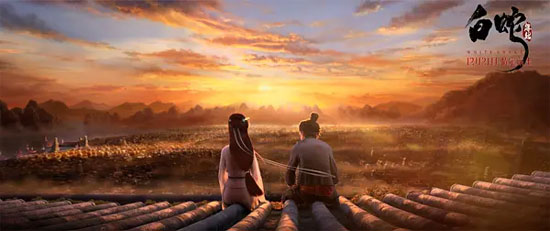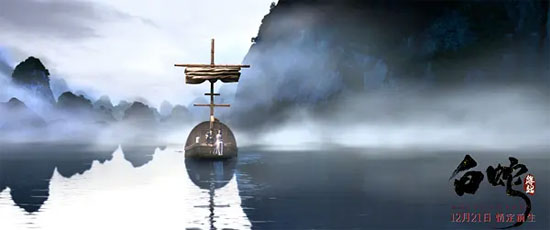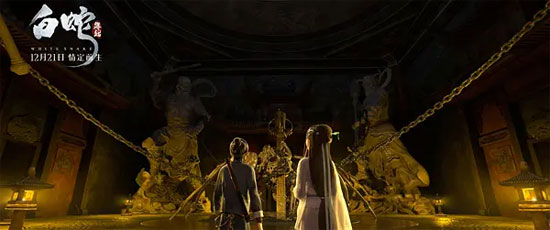Film Name: 白蛇:緣起 / White Snake
As Zhui Guang Animation’s first youth-oriented animated film, the all-or-nothing sincerity in “White Snake” deeply moved me.
The village nestled among the vibrant red maple leaves, the light boat gliding through the vast mountain ranges, the breathtaking sunset scene radiating boundless beauty and warmth, and the picturesque streets and bridges of Zhenjiang—all these elements beckon the soul, captivate the heart, and stir profound emotion.
The five-century cycle of Bai Xiao and Xu Xuan—from their first encounter, to mutual understanding, to love, and finally reincarnation—forms a compelling, focused narrative thread that leaves a lasting impression. From their youthful awkwardness when first taking flight under an umbrella, to their life-affirming chant atop mountains, deep waters, and a light boat, to their tender kiss witnessed by the Buddha, to Xu Xuan and Xiao Bai’s Titanic-like parting, and finally to the White Snake’s heartrending glance back on Zhenjiang’s ancient bridge—the film crafts countless unforgettable, emotionally charged moments.

If I were Xiao Bai, I might truly be transformed by this Xu Xuan. He is so optimistic, so full of vitality, so passionate about life, so upright, and so devoted in loving and protecting the one he cherishes. Ah, he seems flawless. But if I were Xu Xuan, beyond Xiao Bai’s beauty and the kindness I gradually came to feel, what else did I truly love about her? Why does this White Snake deserve—or rather, prove worthy of—Xu Xuan’s love? That deserves further exploration.
A good love story should transform both partners and those around them. The film attempts to address the latter—how Xu Xuan’s villagers evolve from ignorance to enlightenment. It would have been even better if Xiao Qing, by Xiao Bai’s side, could also gain strength from their love to move forward. This narrative attempt is already more profound than typical domestic animations, but it could be made clearer. Particularly, the specific changes each character undergoes remain unclear. How exactly did Xu Xuan’s presence empower Bai Xiaolian to confront her own weaknesses? And how did Bai Xiaolian’s existence transform Xu Xuan from a carefree youth who believed “there’s plenty of time tomorrow” into a man who dared to love and hate, speak his mind, live in the moment, and seize the day?

I don’t quite understand why Xu Xian must become a demon. Whether in Nie Xiaoqian’s story or Bai Suzhen’s tale, love that transcends the boundaries between humans and demons is far more tragic and beautiful than love between demons alone. They possess different physical abilities, different life backgrounds, different lifespans, and different destinies. Yet even so, they meet and fall in love. Isn’t this very struggle to reunite, this winding path to togetherness, precisely what makes it so moving? Why must humans become demons at all?
The most beautiful moment in the film, I believe, is when Xu Xian picks up the jade hairpin and runs toward Xiao Bai and Xiao Qing—and Bai Niangzi turns to glance back. Five hundred years of waiting, karmic ties from past lives, all converge in that instant. This is undoubtedly Xiao Bai’s most crucial gesture; it should have been slowed down, slowed down even more, allowing the audience to linger in that moment longer. Simultaneously, I found myself yearning: had Xiao Bai and Xu Xian shared a similar glance upon their meeting, the sense of destiny would have been even more profound.

The portrayal of the three factions—the Imperial Preceptor, the Serpent Clan, and Baoqing Pavilion—not only enriched the film’s subplots but also provided layers of commentary to the central love story between Xiao Bai and Xu Xian. The Grand Preceptor’s treachery, the Serpent Clan’s ruthlessness, and Baoqingfang’s enigmatic aura—each distinct yet complementary. This balance helps us overlook minor flaws like the Grand Preceptor’s abrupt demise or the Serpent Clan’s “scales that grow in the wrong direction” (scales of the dragon) being handled simplistically.
Perhaps because this is Zhui Guang Animation’s first youth-oriented animated feature, the depiction of demonic arts, illusions, and Baoqingfang’s mysticism—coupled with the male lead’s quintessentially Chinese-style face—unconsciously evokes the aesthetic of the “Painting the Jianghu” series. This highlights the profound influence of the “Painting the Jianghu” franchise as a representative work of youth-oriented and Chinese-style animation. Of course, this might just be my own illusion as a viewer.
Please specify:Anime Phone Cases » White Snake 2019 Film Review: The White Snake Lady’s “Painted Jianghu”